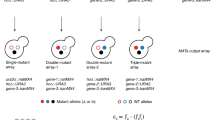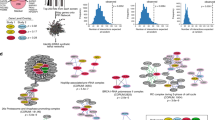Abstract
Systematic genetic interaction studies have illuminated many cellular processes. Here we quantitatively examine genetic interactions among 26 Saccharomyces cerevisiae genes conferring resistance to the DNA-damaging agent methyl methanesulfonate (MMS), as determined by chemogenomic fitness profiling of pooled deletion strains. We constructed 650 double-deletion strains, corresponding to all pairings of these 26 deletions. The fitness of single- and double-deletion strains were measured in the presence and absence of MMS. Genetic interactions were defined by combining principles from both statistical and classical genetics. The resulting network predicts that the Mph1 helicase has a role in resolving homologous recombination–derived DNA intermediates that is similar to (but distinct from) that of the Sgs1 helicase. Our results emphasize the utility of small molecules and multifactorial deletion mutants in uncovering functional relationships and pathway order.
This is a preview of subscription content, access via your institution
Access options
Subscribe to this journal
Receive 12 print issues and online access
$209.00 per year
only $17.42 per issue
Buy this article
- Purchase on Springer Link
- Instant access to full article PDF
Prices may be subject to local taxes which are calculated during checkout






Similar content being viewed by others
References
Phillips, P.C. The language of gene interaction. Genetics 149, 1167–1171 (1998).
Phillips, P.C., Otto, S.P. & Whitlock, M.C. Beyond the Average: the Evolutionary Importance of Gene Interactions and Variability of Epistatic Effects in Epistasis and the Evolutionary Process 20–38 (Oxford Univ. Press, New York, 2000).
Kondrashov, A.S. Deleterious mutations and the evolution of sexual reproduction. Nature 336, 435–440 (1988).
Szafraniec, K., Wloch, D.M., Sliwa, P., Borts, R.H. & Korona, R. Small fitness effects and weak genetic interactions between deleterious mutations in heterozygous loci of the yeast Saccharomyces cerevisiae. Genet. Res. 82, 19–31 (2003).
Elena, S.F. & Lenski, R.E. Test of synergistic interactions among deleterious mutations in bacteria. Nature 390, 395–398 (1997).
Maisnier-Patin, S. et al. Genomic buffering mitigates the effects of deleterious mutations in bacteria. Nat. Genet. 37, 1376–1379 (2005).
Hartman, J.L., IV, Garvik, B. & Hartwell, L. Principles for the buffering of genetic variation. Science 291, 1001–1004 (2001).
Davierwala, A.P. et al. The synthetic genetic interaction spectrum of essential genes. Nat. Genet. 37, 1147–1152 (2005).
Kelley, R. & Ideker, T. Systematic interpretation of genetic interactions using protein networks. Nat. Biotechnol. 23, 561–566 (2005).
Ooi, S.L. et al. Global synthetic-lethality analysis and yeast functional profiling. Trends Genet. 22, 56–63 (2006).
Ooi, S.L., Shoemaker, D.D. & Boeke, J.D. DNA helicase gene interaction network defined using synthetic lethality analyzed by microarray. Nat. Genet. 35, 277–286 (2003).
Pan, X. et al. A DNA Integrity network in the yeast Saccharomyces cerevisiae. Cell 124, 1069–1081 (2006).
Schuldiner, M. et al. Exploration of the function and organization of the yeast early secretory pathway through an epistatic miniarray profile. Cell 123, 507–519 (2005).
Tong, A.H. et al. Systematic genetic analysis with ordered arrays of yeast deletion mutants. Science 294, 2364–2368 (2001).
Tong, A.H. et al. Global mapping of the yeast genetic interaction network. Science 303, 808–813 (2004).
Wong, S.L., Zhang, L.V. & Roth, F.P. Discovering functional relationships: biochemistry versus genetics. Trends Genet. 21, 424–427 (2005).
Wong, S.L. et al. Combining biological networks to predict genetic interactions. Proc. Natl. Acad. Sci. USA 101, 15682–15687 (2004).
Drees, B.L. et al. Derivation of genetic interaction networks from quantitative phenotype data. Genome Biol. 6, R38 (2005).
Segre, D., Deluna, A., Church, G.M. & Kishony, R. Modular epistasis in yeast metabolism. Nat. Genet. 37, 77–83 (2005).
Collins, S.R., Schuldiner, M., Krogan, N.J. & Weissman, J.S. A strategy for extracting and analyzing large-scale quantitative epistatic interaction data. Genome Biol. 7, R63 (2006).
Lee, W. et al. Genome-wide requirements for resistance to functionally distinct DNA-damaging agents. PLoS Genet. 1, e24 (2005).
Giaever, G. et al. Functional profiling of the Saccharomyces cerevisiae genome. Nature 418, 387–391 (2002).
Ashburner, M. et al. Gene ontology: tool for the unification of biology. The Gene Ontology Consortium. Nat. Genet. 25, 25–29 (2000).
Ye, P., Peyser, B.D., Spencer, F.A. & Bader, J.S. Commensurate distances and similar motifs in genetic congruence and protein interaction networks in yeast. BMC Bioinformatics 6, 270 (2005).
Kaliraman, V., Mullen, J.R., Fricke, W.M., Bastin-Shanower, S.A. & Brill, S.J. Functional overlap between Sgs1-Top3 and the Mms4-Mus81 endonuclease. Genes Dev. 15, 2730–2740 (2001).
Shor, E., Weinstein, J. & Rothstein, R. A genetic screen for top3 suppressors in Saccharomyces cerevisiae identifies SHU1, SHU2, PSY3 and CSM2: four genes involved in error-free DNA repair. Genetics 169, 1275–1289 (2005).
Friedl, A.A., Liefshitz, B., Steinlauf, R. & Kupiec, M. Deletion of the SRS2 gene suppresses elevated recombination and DNA damage sensitivity in rad5 and rad18 mutants of Saccharomyces cerevisiae. Mutat. Res. 486, 137–146 (2001).
Ulrich, H.D. & Jentsch, S. Two RING finger proteins mediate cooperation between ubiquitin-conjugating enzymes in DNA repair. EMBO J. 19, 3388–3397 (2000).
Huang, M.E., Rio, A.G., Nicolas, A. & Kolodner, R.D. A genomewide screen in Saccharomyces cerevisiae for genes that suppress the accumulation of mutations. Proc. Natl. Acad. Sci. USA 100, 11529–11534 (2003).
Punnett, R.C. Mendelism (Macmillan, New York, 1913).
Jana, S. Simulation of quantitative characters from qualitatively acting genes. I. Nonallelic gene interactions involving two or three loci. Theor. Appl. Genet. 42, 119–124 (1972).
Ito, T. et al. A comprehensive two-hybrid analysis to explore the yeast protein interactome. Proc. Natl. Acad. Sci. USA 98, 4569–4574 (2001).
Sung, P. Yeast Rad55 and Rad57 proteins form a heterodimer that functions with replication protein A to promote DNA strand exchange by Rad51 recombinase. Genes Dev. 11, 1111–1121 (1997).
Avery, L. & Wasserman, S. Ordering gene function: the interpretation of epistasis in regulatory hierarchies. Trends Genet. 8, 312–316 (1992).
Krogh, B.O. & Symington, L.S. Recombination proteins in yeast. Annu. Rev. Genet. 38, 233–271 (2004).
Lisby, M., Barlow, J.H., Burgess, R.C. & Rothstein, R. Choreography of the DNA damage response: spatiotemporal relationships among checkpoint and repair proteins. Cell 118, 699–713 (2004).
Ellis, N.A. et al. The Bloom's syndrome gene product is homologous to RecQ helicases. Cell 83, 655–666 (1995).
Fabre, F., Chan, A., Heyer, W.D. & Gangloff, S. Alternate pathways involving Sgs1/Top3, Mus81/ Mms4, and Srs2 prevent formation of toxic recombination intermediates from single-stranded gaps created by DNA replication. Proc. Natl. Acad. Sci. USA 99, 16887–16892 (2002).
Liberi, G. et al. Rad51-dependent DNA structures accumulate at damaged replication forks in sgs1 mutants defective in the yeast ortholog of BLM RecQ helicase. Genes Dev. 19, 339–350 (2005).
Prakash, R. et al. Saccharomyces cerevisiae MPH1 gene, required for homologous recombination-mediated mutation avoidance, encodes a 3′ to 5′ DNA helicase. J. Biol. Chem. 280, 7854–7860 (2005).
Schurer, K.A., Rudolph, C., Ulrich, H.D. & Kramer, W. Yeast MPH1 gene functions in an error-free DNA damage bypass pathway that requires genes from Homologous recombination, but not from postreplicative repair. Genetics 166, 1673–1686 (2004).
Meetei, A.R. et al. A human ortholog of archaeal DNA repair protein Hef is defective in Fanconi anemia complementation group M. Nat. Genet. 37, 958–963 (2005).
Bai, Y. & Symington, L.S.A. Rad52 homolog is required for RAD51-independent mitotic recombination in Saccharomyces cerevisiae. Genes Dev. 10, 2025–2037 (1996).
Klein, H.L. Mutations in recombinational repair and in checkpoint control genes suppress the lethal combination of srs2Δ with other DNA repair genes in Saccharomyces cerevisiae. Genetics 157, 557–565 (2001).
McEachern, M.J. & Haber, J.E. Break-induced replication and recombinational telomere elongation in yeast. Annu. Rev. Biochem. 75, 111–135 (2006).
Winzeler, E.A. et al. Functional characterization of the S. cerevisiae genome by gene deletion and parallel analysis. Science 285, 901–906 (1999).
Guthrie, C. & Fink, G.R . (eds.) Guide to Yeast Genetics and Molecular Biology (Academic Press, New York, 1991).
Rose, M.D., Winston, F. & Heiter, P. Methods in Yeast Genetics: a Laboratory Manual (Cold Spring Harbor Laboratory Press, Cold Spring Harbor, New York, USA, 1990).
Erdeniz, N., Mortensen, U.H. & Rothstein, R. Cloning-free PCR-based allele replacement methods. Genome Res. 7, 1174–1183 (1997).
Acknowledgements
We thank M. Evangelista and S. Pierce for critically reading the manuscript; and B. Andrews, C. Boone, J. Greenblatt, N. Krogan and J. Weissman for discussions. R.P.S. was supported by a postdoctoral fellowship from the Canadian Institutes of Health Research. F.P.R. was supported by grant R01 HG003224 from the National Institutes of Health National Human Genome Research Institute (NIH/NHGRI). This work was supported by a grant from the NHGRI awarded to R.W.D. and G.G.
Author information
Authors and Affiliations
Contributions
R.P.St.O. was involved in every aspect of the study, from experimental design and performance to writing the manuscript. R.M. designed and executed algorithms and performed bioinformatic analysis. J.O. performed genetic experiments and growth curves. M.P. designed custom robotics and automation software. E.F. wrote software and performed database management. R.W.D. contributed intellectually throughout to experimental design and execution. C.N. helped design the experiments and write the manuscript. F.P.R. was involved in data analysis and manuscript preparation. G.G. was involved in every aspect of the study, including manuscript preparation.
Corresponding authors
Ethics declarations
Competing interests
The authors declare no competing financial interests.
Supplementary information
Supplementary Fig. 1
96-well growth assay for individual yeast deletion strains. (PDF 141 kb)
Supplementary Fig. 2
Prediction of functional links by 'scaled epsilon'. (PDF 261 kb)
Supplementary Fig. 3
Deletions in genes encoding members of the Shu complex suppress the synthetic lethality of rad54Δhpr5Δ. (PDF 204 kb)
Supplementary Fig. 4
Deletions in HR and SHU genes rescue the MMS sensitivity of the mph1Δmus81Δ double deletion strain. (PDF 193 kb)
Supplementary Fig. 5
Deletions in HR and SHU genes suppress the synthetic lethality of sgs1Δmms4Δ and sgs1Δmus81Δ double deletion mutants. (PDF 308 kb)
Supplementary Fig. 6
Data aggregation identifies additional genetic interactions involving the SHU complex. (PDF 29 kb)
Supplementary Table 1
Chemogenic profiling of the homozygous diploid deletion collection with MMS. (XLS 1927 kb)
Supplementary Table 2
Genetic interaction results for 323 unique gene pairs in the presence of MMS. (XLS 68 kb)
Rights and permissions
About this article
Cite this article
Onge, R., Mani, R., Oh, J. et al. Systematic pathway analysis using high-resolution fitness profiling of combinatorial gene deletions. Nat Genet 39, 199–206 (2007). https://doi.org/10.1038/ng1948
Received:
Accepted:
Published:
Issue Date:
DOI: https://doi.org/10.1038/ng1948
This article is cited by
-
Synergistic enhancement of the mouse Pramex1 and Pramel1 in repressing retinoic acid (RA) signaling during gametogenesis
Cell & Bioscience (2024)
-
Quantitative-enhancer-FACS-seq (QeFS) reveals epistatic interactions among motifs within transcriptional enhancers in developing Drosophila tissue
Genome Biology (2021)
-
Chromatin regulatory genes differentially interact in networks to facilitate distinct GAL1 activity and noise profiles
Current Genetics (2021)
-
Genetic interactions derived from high-throughput phenotyping of 6589 yeast cell cycle mutants
npj Systems Biology and Applications (2020)
-
A self-consistent probabilistic formulation for inference of interactions
Scientific Reports (2020)



